Spring HK International Lighting Fair Draws Throngs of Buyers
2011/05/23 | By Ken LiuMany first-time exhibitors aim to tap thriving Asian economies
This year’s Hong Kong International Lighting Fair (Spring Edition), held April 13-16, saw over 640 exhibitors, a 70% increase over last year, as well as more interesting products.
The higher exhibitor number is due to the thriving non-Japan Asian economies, which have been less impacted by the 2008 financial crisis or the March 11 quake and tsunami in Japan.
The organizer attempted to make sourcing more convenient by staging the lighting fair with the Hong Kong Electronics Fair (Spring Edition) and the Hong Kong International ICT Expo, while comments from buyers and first-time exhibitors prove the lighting event remains a major platform for the global lighting industry.
Various LED lighting made up the majority of exhibits, with indoor lighting far outnumbering outdoor counterparts. The reason: incandescent bulbs are gradually being phased out beginning 2012 in many advanced economies and price gaps between LED and incandescent lamps are narrowing to the make the former competitive.
Paul-Yu Industrial Corp.
Some exhibitors clearly believe in the merit of handcraftsmanship even today. Paul-Yu Industrial Corp. exhibited various stylistic lanterns made of a variety of natural and artificial materials, while buyers did double-takes to flatter the president Paul Yu, who said: “Our catchy products never fail to attract visitors with stylish designs and carefully selected materials.”
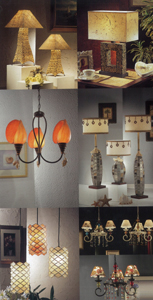
The lantern feature shades of seashells, paper, wood, foliage, stone, rattan, copper, iron, ceramic, glass, bamboo, cloth, PVC and polyresin, on which motifs as well as Chinese calligraphy, painting are printed. “We source materials from countries with exotic origin, with such approach enabling our designers to achieve ethnic themes in the lamps,” Yu noted. The company buys calico from France, botanic paper and coco bark from the Philippines, and cotton paper from Taiwan.
Paul-Yu makes all its products in the Philippines at the four factories inside the Mactan Export Processing Zone in Cebu, with 10 subcontractors outside the zone. “We do all processing inside the factories, including paper carving, seashell processing, rotten bending, printing, metal-parts processing, and lampshade manufacturing,” Yu stressed. The electrical parts, which must meet strict standards, are supplied by European makers.
The company has eight showrooms in the Philippines that display around 3,000 new designs a year. A former high-school fine-art teacher, Yu is passionate about his trade, leading 50 designers, including one each in France and Britain, to develop new products. The maker is virtually unmatched in the variety of product introductions.
Paul-Yu distributes products in 70 nations under the “TAROGO” brand (spun from a name of a national park in Taiwan), mostly in Europe and North America, where about 1,500 containers are shipped annually.
Keeping with the green spirit, Paul-Yu displayed all its lanterns with compact fluorescent and LED bulbs at the fair.
First-timers
The lighting fair also drew many first-time exhibitors who aim to tap the booming economies in Asia, including Tsann Kuen (Zhang Zhou) Enterprise Co., Ltd., a subsidiary of household appliance retailer Tsann Kuen Enterprise Co., Ltd. of Taiwan.
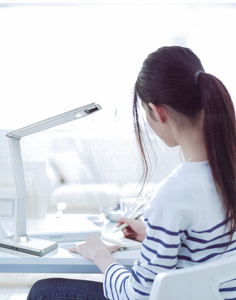
“Exhibiting the first-time this year shows our determination to tap the other Asian markets,” said Andrew Huang, the VP of sales.
Tsann Kuen showcased mostly household LED lamps, including E26/27 light bulbs, desk lamps, wall lamps, and ceiling lamps. “Our desk lamps are superior for being glare-free,” Huang stressed, who shows the household appliance magazine Trendy Magazine of Japan that rates his company’s LED bulbs as qualitatively equal as Panasonic in CRI, efficacy but cheaper.
Some of the desk lamps displayed are solar powered, while others have USB port but all are slim and sleek.
Huang said that the company’s light bulbs and ceiling lights are very popular in Japan while its desk lamps are sold mostly to China, South Korea, Southeast Asia and Taiwan. The company promotes in developing markets under the “FOR A” brand and are sold as OEM products in developed markets.
Tsann Kuen’s lamps are sold in Japan via the retail chain Yamada. “Strong eco- consciousness in Japan helps our business more than in other countries,” Huang noted.
The company started making LED lighting fixtures two years ago and LED light bulbs last year to tap the promising future of such lighting. Huang said that the company’s 30 years of experience in the household appliance sector helps it to design LED lighting.
SFT Holland Cooperatie
Also a first-time exhibitor, SFT Holland Cooperatie U.A. of the Netherlands promoted a line of unique LED light bulbs dubbed “Magnolia” for the floral look.
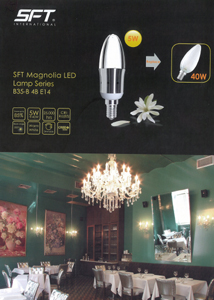
The maker installed the floral-shaped LED bulbs in chandeliers to tap their inherent form. Chandeliers are perfect to showcase the floral-shaped bulbs for the 300-degree illumination angle,” boasted Gordon Tan, the chief marketing manager.
Tan justified developing the LED Magnolia, for incandescent bulbs, despite the omni-directional illumination, are extremely energy wasting.
The Magnolia LED bulbs have both wide beam angle and efficient cooling. Tan said that the floral bud design has cooling slots to allow heat to escape, while heat from the power driver escapes from the holes on the housing, all of which achieves excellent efficacy.
A 5W Magnolia is rated at 60 lumen-per-watt, which Tan said is bright enough for Chinese users for they believe dim chandeliers bring bad luck in the tradition of “feng shuei” or geomancy. The bulbs achieve also 2700 K warm-white light and 85 CRI, comparable to the 100 CRI of incandescents.
SFT debuted the patented Magnolia bulbs in October last year, claiming them to be the world’s first LED bulbs for chandeliers that last 25,000 hours, Tan said, adding that shortly after a lighting fair in Japan in January this year, an order for 400,000 bulbs from Japanese buyers were received.
Simon Group
The Barcelona, Spain-headquartered Simon Group was another first-time exhibitor. A world leading manufacturer of low-voltage lighting accessories, lamps and control systems, the company displayed a variety of switches, power sockets and lighting electrical parts.
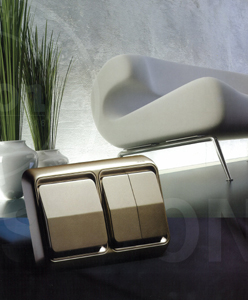
The Simon 50 and 52 series of switches showcased feature non-slip structure and special nylon formula to significantly reduce friction. Extending creepage distance and improved structural design effectively reduce arcing to ensure safety amid humid environment.
The company attended the HK event to tap opportunities in Asia outside China and India, where it has set up manufacturing and marketing operations.
“We plan to focus marketing in Asia over the next few years for its much stronger economic growth, and expect to generate US$10-15 million in revenue from Asian markets outside China and India, an ambitious goal,” said Peter Bao, Director of International Business Department of the China headquarters, Simon Electric (China) Co., Ltd.
Bao’s confidence is reflected by the group’s impressive sales growth in China, reaching 30-50% over the past few years.
The company’s electrical parts are installed in the China National Stadium (the Bird Nest) and National Aquatic Center (the Water Cube), among others.
Bao said that the company will open an office in Vietnam in May 2011, and set up assembly lines in cooperation with partners in other Association of Southeast Asian Nation (ASEAN) members, whose potential is considerable especially in three to five years when duties will be eliminated. The maker will then target marketing in Japan and South Korea, where success will depend on quality not price.
The company’s LED lamps, which are sold in Europe, will be distributed in Asia by June. “Though most competitors are promoting LED lamps as primary products in Asia, we believe in having a well-thought-out plan before venturing into a segment,” Bao stressed.
Bao observed that the HK event suits mid-range products, positioned between the high-end Frankfurt lighting fair and low-end Guangzhou counterpart. “Our attendance is perfectly timed for we believe this is the first lighting event after the global crash in 2008.”
The maker displayed various light switches and power sockets to show its capacity to turn out electrical parts to meet different standards. “Asia does not have unified industrial standards for electrical parts as in Europe and North America, so we face greater challenges,” Bao stressed.
Bao is confident of the company’s capacity to meet different specifications based on its century-old experience in manufacturing. The Spanish conglomerate was founded in 1916 and commands over 60% of the nation’s switches and power sockets segments, as well as generating globally revenue of around 400-500 million euro a year.
Partnership
The lighting fair showed promise for Taiwan-made LED devices. Shenzhen MTC Lighting Co., Ltd. and the Dutch-owned, Shanghai-headquartered Tuono Lighting International are among the Chinese manufacturers using such devices from Taiwan and others. However conclusions cannot be drawn without thorough investigation for the trend may just be due to particular instances of aggressive salesmanship.
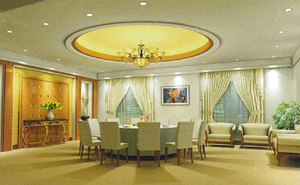
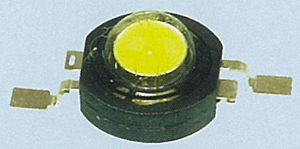
Shenzhen MTC displayed high-power LED packages for such lights as down lights, flood lights and more, in which are installed LED chips from Semileds Corp., Epistar Corp., and Chi Mei Lighting Technology Corp. of Taiwan as well as devices from Cree Inc. and Bridgelux Inc.
The sales manager Max Cheng said that product competitiveness is attributable to Taiwan-made devices and Taiwan-trained LED specialists. “Taiwanese and South Korean LED technicians enable us to achieve defect-free rate far above industrial averages, as well as efficient production and volume production in less than three months,” said Cheng.
Shenzhen MTC aims to generate revenue of RMB300 million (US$46 million) this year and triple that in three years from sales in Eastern, Western Europe and North America, particularly selling light sources in Eastern Europe and light fixtures in Western Europe and North America.
The company believes the earthquake and tsunami in Japan will bring opportunities to China’s LED-lighting manufacturers. “Rebuilding in the aftermath will sap already short power resources in Japan, hence making LEDs very attractive and perhaps the only lighting choice to replace traditional counterparts.”
Tuono Lighting
Tuono Lighting eagerly promoted its Baleno brand at the HK event that was debuted three years ago in its LED lights that are equipped with LED chips from Taiwan’s Epistar as well as chips from big-name suppliers in advanced economies.
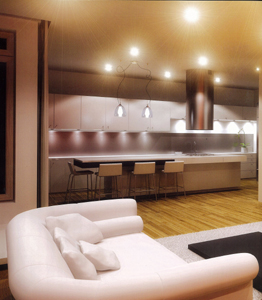
The company’s cabinet lights are especially bright, come with touch switch and slim design. “Compared to most of the existing counterparts, our cabinet lights are very slim at only 10mm in height and well designed,” said the Dutch-born general manager for the China operations, Gertjan Dieleman.
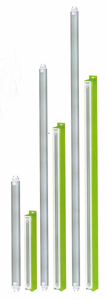
Lighting fixtures must be both stylish and functional. “So we designed cabinet lights to be very compact to replace halogen lights, which are typically used under cabinets,” Dieleman stressed. The cabinet lights have three LEDs for 530 lumens and are more than bright enough for most work environments.
One model of the under-cabinet light uses multichip packages and touch switch. “We designed the light to be very user-friendly, with touch switch to allow users to literally turn on the light blindfolded,” Dieleman said. Another type with touch switch is the linear under-cabinet light that are very suitable for cabinets in kitchens and bathrooms as well as shelves and bookshelves.
Dieleman lauded LEDs for being a very genius invention, whose compactness liberalizes design limits and allows development of slim, elegant lamps for installation in existing fixtures. “Slim and elegant designs inspire us to develop light fixtures that double as heat sinks to eliminate cooling modules,” he noted.
The company offers a three-year warranty on products. “Actually we guarantee 35,000-50,000 hours in service life since the aluminum fixtures effectively stops heat build-up beyond body temperature,” emphasized the Tuono China General Manager.
Though a young company, Tuono, Dieleman said, has been growing fast over the past two years or so mostly due to increasingly positive attitude towards LED. “We’ve seen increasingly more businesses start lighting projects by replacing halogens and incandescents with LEDs.” So far, the company has sold products in eight to nine European countries, the Middle East and Australia, targeting retailers and wholesalers.
Aeopto Technologies
A high-profile first-time exhibitor was Aeopto Technologies Co., Ltd., wholly owned by Tongfang Optoelectronic (HK) Ltd. that is held by the China state-owned Tsinghua Tongfang Co., Ltd., known for its information-technology equipment.
The company mostly promoted LED lamps, including bulbs, light tubes, ceiling lights, MR16 spotlights, PAR lights, strip lights, sunken lamps, project lights, streetlights, and tunnel lights, all of which adopt a unique technology to minimize static electricity. “Static is highly destructive to LED devices,” said Marco Wu, a commissioner of the operations center handing marketing and brand management.
Tsinghua Tongfang entered into the LED sector around one year ago and has installed about 14 MOCVD (metal organic chemical vapor deposition) chambers to make epitaxy wafers, the raw material for making LED chips, said Wu.
Innovative Exhibitor
With innovation always a prominent theme at lighting fairs, Shenzhen Ruizi Light Electricity Technology Co., Ltd. lived up to the claim this year.
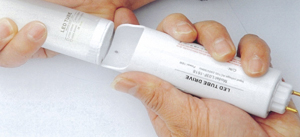
Shenzhen Ruizi, owner of the ERVAN brand, promoted only LED light tubes, whose design departs strikingly from generic counterparts with independent driver that is integrated in a replaceable housing. “Simply replace burnt out drivers with a new one to achieve cost-efficiency,” said chairman David Huang, who showed the ease with which to replace the housing by pulling out the ends.
Huang expects such user-friendly design to help boost product popularity by cutting cost. Besides relatively high retail price, LED lights still are not popular due to reliability of electrical components to match longevity of LED lights, a shortcoming thus addressed by Shenzhen Ruizi’s new design.
Huang is betting on developing LED fluorescent-replacements instead of LED lighting as the way to success.
The maker also showed another unusual light tube, one that has rotatable electrodes that allow users to turn light tubes, enabling light output from front and back as needed.
Another practical item shown was an unconventional LED emergency light tube, with an independent power supply, to enable operation for four hours if necessary.
Shenzhen Ruizi distributes light tubes are installed in supermarkets, offices, parking lots, factories, subways, department stores, refrigerators and vending machines, as well as delivered with a three-year warranty, likely due to being installed with Taiwan-made LED packagers. “Taiwan-made LED devices are sound and less expensive,” Huang commented, adding that the LED chip industry in China is just emerging.
Shenzhen Ruizi is developing light tubes that are controlled by Wi-Fi-enabled mobile devices. “We develop controller software in Japan and controllers in Shenzhen,” Huang said.
HEC Group
The HEC Group of Taiwan showcased LED drivers, the equivalent of critical electronic ballast in fluorescent lighting fixture, which underlined the importance of the electronic devices for LED lighting.
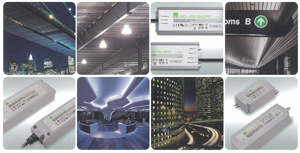
Founded in 1979, the group has utilized its expertise in power-supply and computer-casing manufacturing, set up some 10 years ago, to build its driver manufacturing operations. The maker displayed constant-voltage drivers, constant-current drivers and combination drivers, which are for DC dimming and use analog and digital pulse width modulation (PWM) technologies. PWM technology further narrows dimming gaps relative to that for analog technology to smooth luminosity adjustment.
The trend for the device is now tri-directionally driven: reliability or longevity, dimmablity, and high input-output efficiency, said Isaac Liu, manager of HEC’s open-frame department.
Mean time between failure (MTBF) measures reliability, which rates the company’s drivers at above 43,000 hours compared with the industrial average of 30,000 hours, with the volt-to-lumen conversion efficiency being 85-90%. The maker uses Japan-made electrolytic capacitors to assure quality of drivers.
The group supplies approximately 100 models of LED drivers that are installed in own-labeled LED lamps and ones made by North American, European, Chinese, Japanese and South Korean manufacturers, with all the products meeting standards as UL of North America, TUV of Europe, KEMA of Holland and PSE of Japan.
The group has a branch each in Germany, the United States, Britain, South Korea and Japan to handle marketing, while production takes place in its China factory.
Foreign Buyers
Many buyers were attracted to the spring lighting fair, despite it being only the third edition, a sign of the importance of the event. Among the buyers were Sascha Schwalbe, CEO of GPSTEC Ltd. in Thailand; Krzysztof Marek Paramuszczak, Managing Partner of Smartie Management Support in Poland; T. C. Lim, Owner of Lindner Electrical Sdn. Bhd. in Malaysia; Vadim Senechkin, Chief Executive of Russia’s Compact-Optima Ltd,; Julia Sheiko, Brand Manager of Real Group of Russia; and Takashi Hattori, Deputy Manager of Product Planning Div. of Japan’s Unison Corporation.
Schwalbe claimed to have ordered on the first day approximately US$70,000 in LED lighting products, adding that he looked to source LED spotlights for his online retail business and the event offered mass market products.
Paramuszczak is a consultant who looked for new suppliers for clients. “This show keeps me well informed of the latest lighting technologies. I used to attend the Spring Electronics Fair to see lighting products, but this lighting fair offers so much more after being spun off three years ago,” he said.
Lim is a lighting wholesaler and feels visiting the Hong Kong lighting fair is more convenient than to travel to Europe. “There are so many exhibitors and products at the Hong Kong fair and I met not only existing suppliers in China and Hong Kong but also new suppliers.”
Senechkin, a first-timer at the show, came to gather information on suppliers of LED and energy-saving lighting for offices, factories and streets. “Energy-saving lighting is already widespread in Russia despite the infancy of the LED market.”
Sheiko, also a first-time visitor, looked for new suppliers. “We distribute decorative lighting for home and hotel projects in Russia. This show is very convenient to find these products.”
Hattori’s company branched out into supply of alfresco lighting for households from manufacturing bricks, stones and pebbles for gardens. Also a first-time visitor, Hattori searched for components and LED lighting suitable for outdoor applications. “We see plenty of opportunities for our lighting business although alfresco is not yet a trend in Japan. I am only interested in LED products, which is a growing market in Japan, and have found some good products, including new designs for lights and a transformer.”

